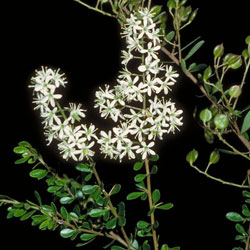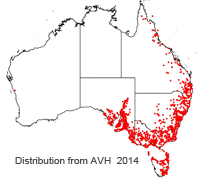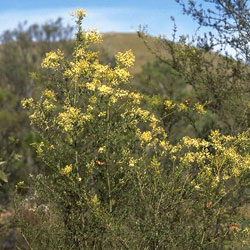Bursaria spinosa
 Bursaria spinosa subsp. spinosa |
Native Blackthorn, Sweet Bursaria, Christmas Bush
Bursaria spinosa Cav.
Bursaria spinosa is a member of the Pittosporaceae family. It has two accepted subspecies, B. spinosa subsp. spinosa and B. spinosa subsp. lasiophylla. B. spinosa has many common names but the more frequently-used ones include Native Blackthorn, Sweet Bursaria, and Christmas Bush (in S.A. and Tas.). It also has two Aboriginal names: geapga and kurwan (Dharawal).
 Bursaria spinosa is a medium to large shrub or small tree, growing to 5–10 metres high. Height can vary based on habitat; the coastal forms are known for being rather tall, while those found in subalpine areas can be almost prostrate. It is often multi-stemmed and has a rhizomatous root system, from which is can readily re-sprout after disturbance. The branches are usually spiny. The leaves are small (1–5 cm long), obovate and often clustered on the branches. In spring to summer it produces numerous small (1 cm across) white to cream flowers, which are nicely fragrant. Following this it produces characteristic purse-/heart-shaped seed capsules, inside which, when mature, the seeds rattle in the wind (one of its other common names is Castanet Bush). This species grows from coastal to subalpine areas of eastern and south-eastern Australia, including Queensland, New South Wales, Victoria, Tasmania and South Australia. B. spinosa subsp. lasiophylla has slightly smaller, rounder leaves and smaller flowers and a narrower range. It also prefers heavier clay soils and higher altitudes than B. spinosa subsp. spinosa.
Bursaria spinosa is a medium to large shrub or small tree, growing to 5–10 metres high. Height can vary based on habitat; the coastal forms are known for being rather tall, while those found in subalpine areas can be almost prostrate. It is often multi-stemmed and has a rhizomatous root system, from which is can readily re-sprout after disturbance. The branches are usually spiny. The leaves are small (1–5 cm long), obovate and often clustered on the branches. In spring to summer it produces numerous small (1 cm across) white to cream flowers, which are nicely fragrant. Following this it produces characteristic purse-/heart-shaped seed capsules, inside which, when mature, the seeds rattle in the wind (one of its other common names is Castanet Bush). This species grows from coastal to subalpine areas of eastern and south-eastern Australia, including Queensland, New South Wales, Victoria, Tasmania and South Australia. B. spinosa subsp. lasiophylla has slightly smaller, rounder leaves and smaller flowers and a narrower range. It also prefers heavier clay soils and higher altitudes than B. spinosa subsp. spinosa.
This species is fairly hardy and easy to grow. It doesn’t require much maintenance and grows in most conditions. It can be grown from seed or cuttings. Fresh seeds will produce the best germination results, in a standard seed-raising mix. Cuttings should be semi-hard wood, about 10cm long and taken from the current season’s new growth. Young plants should be watered regularly for the first couple of years, but they will look after themselves after that. Some minor limitations to cultivating this plant are the possibility of scale insect infestation and that the species has the potential to become invasive in moist areas.
The flower and uniquely shaped seeds of B. spinosa can be used as indoor displays. Its spiny branches make this species useful as a deterrent shrub or barrier, and it can be pruned if required. The fragrant flowers are known to attract butterflies, and this species is important in the conservation of the Eltham Copper Butterfly in Victoria, whose larvae feed exclusively on the leaves of B. spinosa. The leaves of this species contain a secondary compound called aesculin (a coumarin glucoside), which was exploited as an ingredient in sunscreens in the 1940s and is used in medical research today. Overall, B. spinosa is an interesting and attractive native species for any garden.
Text by Katherine Willis (2014 Student Botanical Intern)
Name meaning: Bursaria spinosaBursaria - from the Latin ‘bursa’, for bag or purse, referring to the purse- or heart-shaped seed capsules. spinosa - in reference to the spines often present on the branches. |
References:
Australian Government, Department of Defence (2005) Landscaping for biodiversity: Australian Capital Territory endemic species planting guide, Coordination and Public Affairs, Department of Defence, Canberra, A.C.T.
Bayes, E., Douglas, F., Whitfield, J., Van Praagh, R.D., Field, R.P., Yen, A.L. & New, T.R. (2012) Surveys for the Eltham copper butterfly Paralucia pyrodiscus lucida Crosby (Lycaenidae) in Victoria in late 2011, The Victorian Naturalist 129(3): 114-118
Cayzer, L.W., Crisp, M.D. & Telford, I.R.H. (1999) Bursaria (Pittosporaceae): a Morphometric Analysis and Revision, Australian Systematic Botany 12: 117-143
Conn, B.J. & Coveny, R.G. (1999) Bursaria spinosa Cav., PlantNet - The Plant Information Network System of The Royal Botanic Gardens and Domain Trust, Sydney, Australia (version 2.0). Available at http://plantnet.rbgsyd.nsw.gov.au/cgi-bin/NSWfl.pl?page=nswfl&lvl=sp&name=Bursaria~spinosa [Accessed 13 February 2014]
Elliot, W.R. & Jones, D.L. (1982) Encyclopaedia of Australian Plant suitable for cultivation, Lothian Publishing Company, Melbourne.
Jebb, M & Andrews, S (2001) Plate 425 Bursaria spinosa, Curtis's Botanical Magazine 18(3): 163-169
![An Australian Government Initiative [logo]](/images/austgovt_brown_90px.gif)


